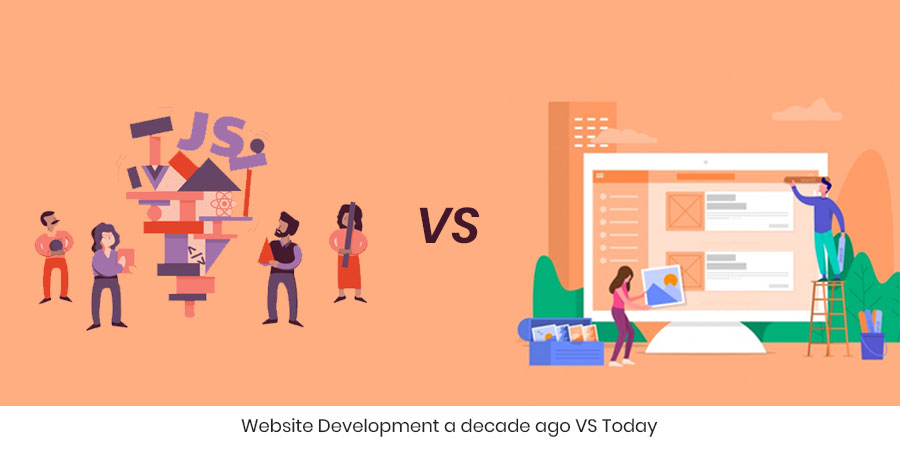
Website Development a decade ago VS Today
If you are working with Website Development, you would be aware of Website Stack! There has been a lot of changes and development in this field. Over the past years, there has been a constant change being involved and evolved.
The changes in Development includes technology stacks, frameworks, and programming languages.
These changes are often taking place in small sections of web development such as version control, or dependency management.
The next 6 minutes you are going to deal with how the Website Development was 10 years ago!
Web Development 10 years ago

Ten years ago web development was a distinct place. Node JS had not yet vented onto the scene (being written in 2009), and utmost developments were being done in languages like Python and PHP. We have compiled a (by no means exhaustive) list of technologies you might have been working ten years ago (some of which are still in use today), compared with what is trendy now.
Text Editors
Text Editors involve a large part of a web developers workflow, and when it comes to 10 years back more IDE’s have been used for Website Development.

These were the two main text editors that were used:
- Sublime Text.
- Notepad++.
Database

The Database which you make use of depends on the expectations and needs. A Decade ago the requirements were quite straightforward and there weren’t as many alternatives to the obvious choices like MySQL.
These were the common Databases that were used:
- MySQL.
- Oracle.
- PostgreSQL.
Backend
The Backend of the application controls the logic and critical pieces that allow a user to interact with your website in meaningful ways, similar to creating an account.
These were some of the Backend languages that were used:
- PHP.
- Python.
- Ruby.

Front End
Front End of an application acts to be the face of your organization. The front end technology is associated with the User Experience. Although ten years ago much of the technology was alike, the methodologies that were applied were very different.
These were the common Front-End tools being used:
1. HTML/CSS.
2. Javascript (JQuery).

Deployment Tools
The Final step of the website development is the Deployment stage. Deployment, or how you put your website online looked very distinct from how it does today.
These were the ways through which Deployment was done:
- FTP (Cyberduck).
- Shared Hosting.
- VPS.
Web Development now
In the recent 10 years, the website development has witnessed a lot of changes. For instance, JavaScript has ventured onto the web development scene, expanding much further into the backend of the stack and exploding with extra frameworks and innovative methods for development on the frontend.
Text Editors

Nowadays, Text Editors are used more versatile and have the capacity to be extended with plugins. Most, obviously inspired by Sublime Text, are also very pleasing to the eye. And Brackets is even ready in a web browser.
These are the common text editors that are being used:
- Visual Studio Code.
- Atom.
- Brackets.
- Sublime Text.
Database

The database was moreover the same, with the addition of NoSQL which stores data differently than a relational database. These databases are depreciating in popularity for traditional apps but still remain prevalent for unstructured data.
These are the most common Database being used:
- MySQL.
- MongoDB.
- Redis.
Back End
The Backend environment nowadays is completely loaded with Javascript and Node Js. Node has found its way into various distinct stacks, and with frameworks like React, even large companies (like Walmart, Amazon, Google, etc.) are now doing significant backend development in Javascript.
Back-end technologies include:
- Javascript.
- Ruby.
- Python.
- PHP.
Front End
There were not much more changes noticed in Front End Development for the application. But it has seen an explosion of JavaScript frameworks that make it clear to couple the visual parts of your website with the backend.
Front-End uses these essential components:
- HTML/CSS.
- Javascript (React, Vue, Angular, JQuery).

Deploying Tools
Deployment and hosting tools have become more important and more complex in just ten years. And there are numerous tools to choose from.
These were the common Deploying tools used:
- Grunt/Gulp
- Webpack
- CI/CD
- Git (Github)
- Static Hosting (AWS, Netlify)
- Uptime Monitoring (Uptime Robot)
To Close
By seeing what changes over we can see some innovation that you have to investigate it develops, and you may likewise have the capacity to gain from the error of holding up too long to bounce in on another progression. In this article, we’ve gone over what a stack looked like 10 years back, and we’ve demonstrated to you what they look like today.
In case you’re firmly required with web improvement, you realize that your site stack has advanced and changed since you originally began. Throughout the years there has been a principal move in the way web advancement has been completed crosswise over innovation stacks, structures, and programming dialects.
By investigating how this has advanced you can begin to welcome the majority of the littler apparatuses that have turned into a necessary piece of your work process.

Gayatri being the Head of Operations at Sumanas Technologies is an obsessive Content Developer with her keen interest in writing. She keeps eye on the current happenings in the software industry to remain updated with the recent market trends. Her contents cut through the noise which makes the readers relish.

One thought on “Website Development a decade ago VS Today”
Comments are closed.
Leave a Comment
sign in to post your comment or signup if you dont have an account.